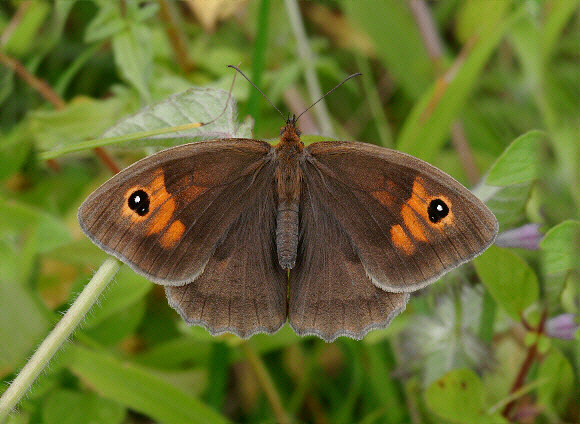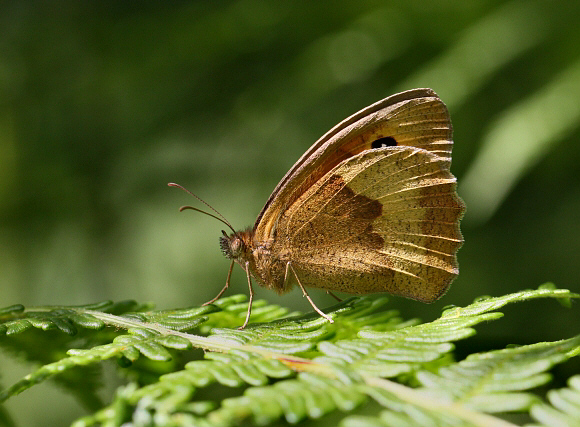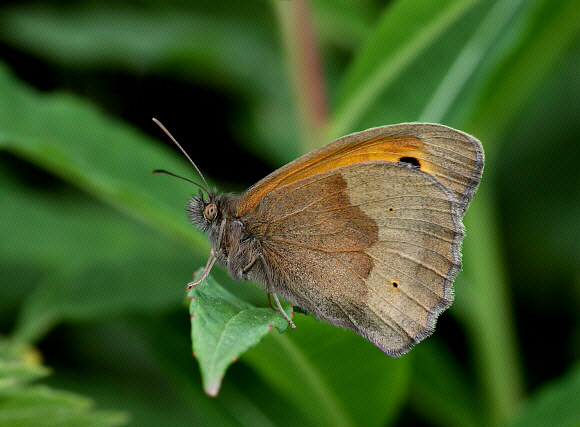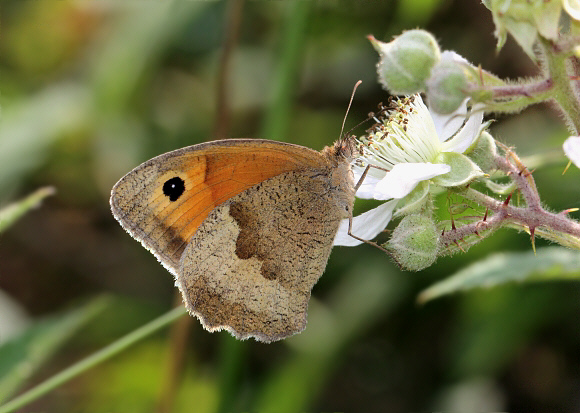
Introduction
The Meadow Brown is one of the commonest and most widespread species in Europe, absent only from sub-arctic areas of Scandinavia. Beyond Europe it occurs in Morocco, Algeria, Turkey, the Middle East, and eastward to the Urals and western Siberia.
Meadow Browns are subject to a degree of variation in the extent and brightness of the orange areas on the upper wing surface, particularly in the females, in which the orange suffusion spreads across into the basal area. It is also common to find pathologically aberrant specimens, particularly females, which are marked with irregular and asymmetrical whitish patches on the uppersides.
There are several similar species which occur on Mediterranean islands ( M. megala , chia, nurag & halicarnassus ), in northern Africa ( Pyronia janiroides, Hyponephele moroccana ) and the Middle East ( Maniola telmessia, Hyponephele lycaon & H. lupina ).
Meadow Brown Maniola jurtina female, Bedwyn Brail, Wiltshire – Adrian Hoskins
Habitats
100 years ago the Meadow Brown could be found in almost any grassy lowland habitat throughout the British Isles. Today although it is still very widespread and often abundant, it has become more localised. It is found in the greatest numbers on ungrazed calcareous grasslands, woodland glades and grassy rides; but also occurs commonly on damp heathlands, undercliffs, hay meadows, road verges, fallow fields and along hedgerows. In many of these habitats populations run into several hundreds, and at the best sites can be counted in tens of thousands. Smaller populations occur on grazed grasslands, cliff tops and coppiced woodland but the butterfly is almost entirely absent from so-called ‘improved’ pastures which have been subjected to the application of fertilisers.
Lifecycle
The Meadow Brown is single brooded ( even in southern Europe and north Africa ), but has a very protracted emergence beginning in early June and extending into September. There is no evidence to support the theory that the butterfly is double brooded. Emergence times are in fact controlled by genetics – offspring which inherit certain types of gene will have a short larval development period, producing early adults, while those inheriting a different combination of genes have larvae which develop much more slowly, producing the later adults.
The eggs are spherical, straw coloured, with reddish blotches. They are laid singly on or amongst grasses, sometimes glued to stems or grass blades, but often just dropped into the vegetation by perching females.
The larvae hatch after about 14 days. They feed on a wide range of grasses including Festuca ovina, Brachypodium pinnatum, Holcus lanatus and Agrostis setacea, but strongly favour smooth meadow grass Poa pratensis, avoiding the coarser leaves. Larvae which hatch in June or early July feed up quite slowly, reaching their 2nd instar in early October. The offspring of later-emerging adults may not hatch until late August or September. Both they and the early hatching larvae spend the winter months hibernating singly at the base of grass tussocks, although they sometimes emerge to feed in mild weather, even in mid winter.
In earlyMarch they awaken fully from their semi-diapause, and after a few evenings of feeding they are ready to moult their skins and enter the 3rd instar. The over-wintered larvae develop at various rates, achieving full growth at sometime between May and late August. When fully grown they are slightly hairy, bright green in colour, and have a dark stripe along the back and pale lines along the sides. The caudal prongs are white. The larvae feed nocturnally. At dusk can be found sitting near the top of grass stems. During daytime they hide deep in the tussocks. About 25% of the larvae are killed by the parasitoid wasp Apanteles tetricus. Other causes of larval mortality include bacterial pathogens and predation by birds and spiders. Total mortality occurring between eggs hatching and adult butterflies emerging has been estimated at 43% of the population.
The pupae are variable, some having a bluish-green ground colour, while others are almost white. Dark chestnut or blackish varieties also occur. All forms are marked with prominent black stripes on the wing cases and dark dots along the back. They are suspended from grass stems or blades, with the shrivelled larval skin still attached to the cremaster. The pupal stage lasts about 3 weeks.

Adult behaviour
Meadow Browns spend long periods nectaring, usually with their wings closed, on a wide variety of wild flowers including knapweeds, thistles, heathers, bramble blossom, ragwort, hogweed, small scabious, devil’s bit scabious, privet, wild basil, marjoram, hawkbit and hemp agrimony. In hazy or weak sunlight the butterflies bask on bushes, or amongst grasses, but when conditions are overcast or cool they hide amongst low vegetation.
Copulation occurs following a very brief courtship ritual, in which the female adopts a fluttering and gliding flight just above the grasses, while the male flutters very closely behind her, almost making physical contact during flight. Copulated pairs remain very alert and readily take flight if disturbed, with the female carrying the male. Meadow Browns have often been found copulated with other Satyrine species including Gatekeeper, Ringlet and Marbled White, and on rare occasions have even been known to copulate with Small Tortoiseshells.
It is very common to find adults infested with tiny red mites which attach themselves to the head, thorax or legs of the butterflies. These Arachnids pierce the soft membrane between the segments, and feed on the bodily fluids, but do not appear to cause any significant harm to their hosts. The mites, Trombidium breei, are particularly common at chalk grassland sites, where they also attack Marbled Whites, Common Blues, Chalkhill Blues and Small Skippers.


